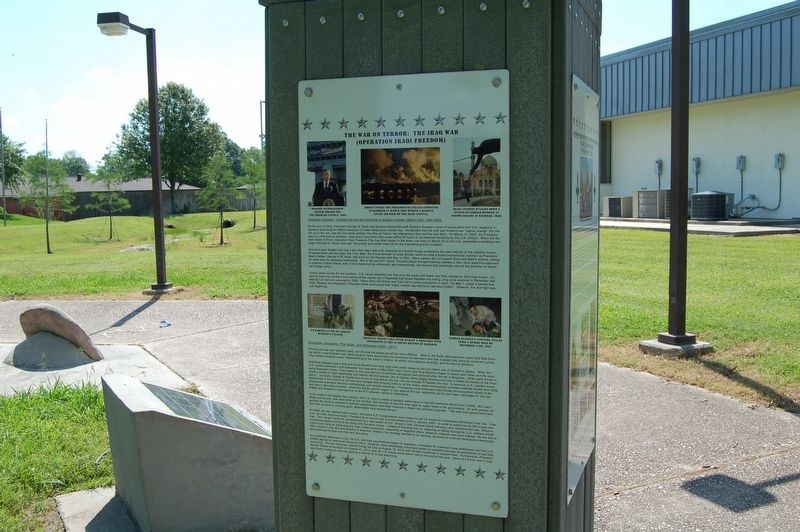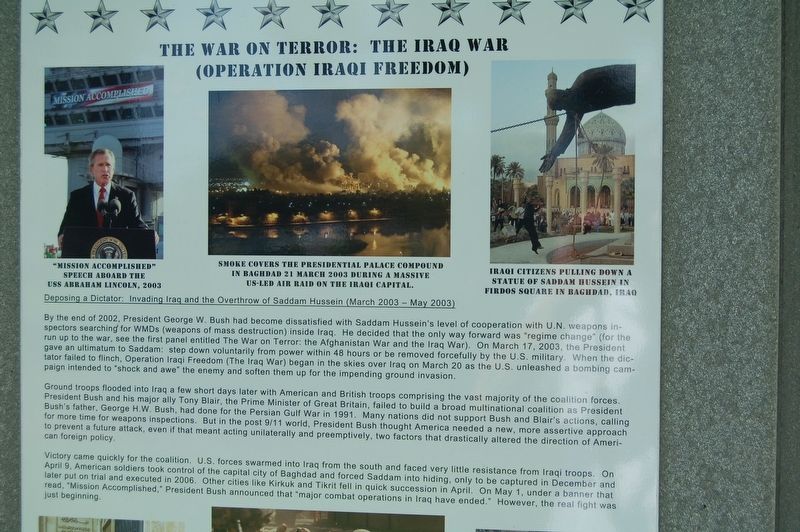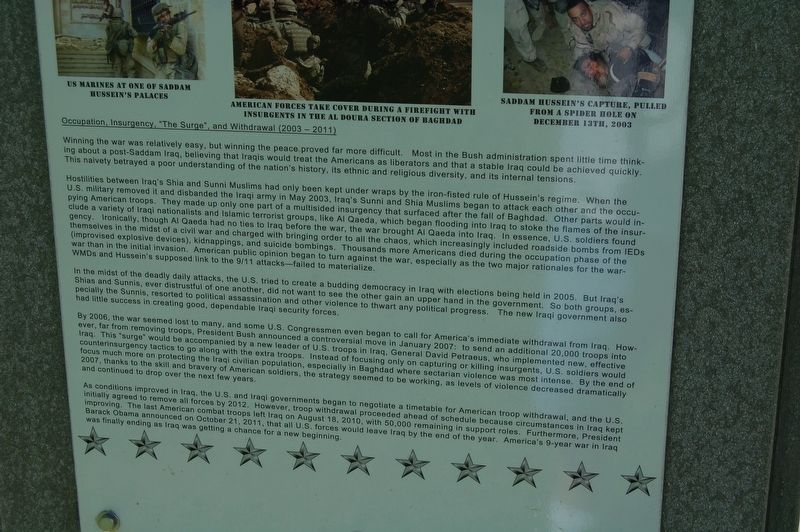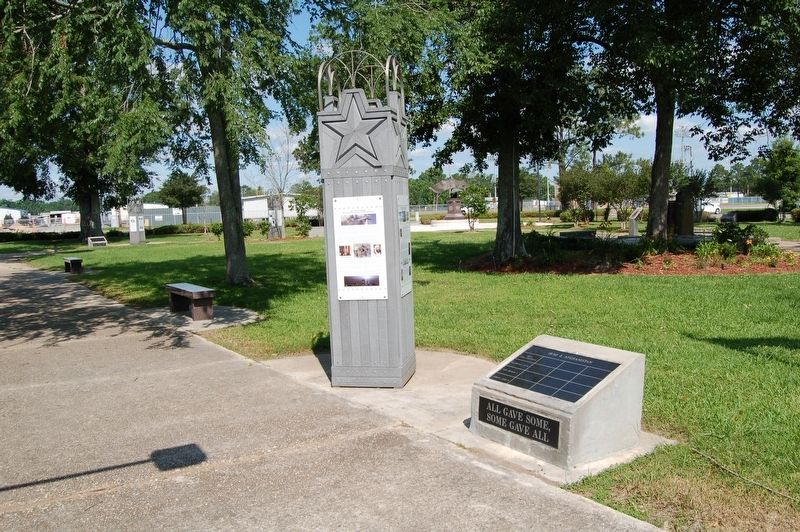War on Terror: The Iraq War
(Operation Iraqi Freedom)
Deposing a Dictator: Invading Iraq and the Overthrow of Saddam Hussein (March 2003 – May 2003)
By the end of 2002, President George W. Bush had become dissatisfied with Saddam Hussein's level of cooperation with U.N. weapons inspectors searching for WMDs (weapons of mass destruction) inside Iraq. He decided that the only way forward was “regime change" (for the run up to the war, see the first panel entitled The War on Terror: the Afghanistan War and the Iraq War). On March 17, 2003, the President gave an ultimatum to Saddam: step down voluntarily from power within 48 hours or be removed forcefully by the U.S. military. When the dictator failed to flinch, Operation Iraqi Freedom (The Iraq War) began in the skies over Iraq on March 20 as the U.S. unleashed a bombing campaign intended to “shock and awe" the enemy and soften them up for the impending ground invasion.
Ground troops flooded into Iraq a few short days later with American and British troops comprising the vast majority of the coalition forces. President Bush and his major ally Tony Blair, the Prime Minister of Great Britain, failed to build a broad multinational coalition as President Bush's father, George H.W. Bush, had done for the Persian Gulf War in 1991. Many nations did not support Bush and Blair's actions, calling for more time for weapons
inspections. But in the post 9/11 world, President Bush thought America needed a new, more assertive approach to prevent a future attack, even if that meant acting unilaterally and preemptively, two factors that drastically altered the direction of American foreign policy.Victory came quickly for the coalition. U.S. forces swarmed into Iraq from the south and faced very little resistance from Iraqi troops. On April 9, American soldiers took control of the capital city of Baghdad and forced Saddam into hiding, only to be captured in December and later put on trial and executed in 2006. Other cities like Kirkuk and Tikrit fell in quick succession in April. On May 1, under a banner that read, “Mission Accomplished,” President Bush announced that “major combat operations in Iraq have ended." However, the real fight was just beginning.
Occupation, Insurgency, “The Surge”, and Withdrawal (2003 - 2011)
Winning the war was relatively easy, but winning the peace proved far more difficult. Most in the Bush administration spent little time thinking about a post-Saddam Iraq, believing that Iraqis would treat the Americans as liberators and that a stable Iraq could be achieved quickly. This naivety- betrayed a poor understanding of the nation's history, its ethnic and religious diversity, and its internal tensions.
Hostilities between Iraq's
Shia and Sunni Muslims had only been kept under wraps by the iron-fisted rule of Hussein's regime. When the U.S. military removed it and disbanded the Iraqi army in May 2003, Iraq's Sunni and Shia Muslims began to attack each other and the occupying American troops. They made up only one part of a multisided insurgency that surfaced after the fall of Baghdad. Other parts would include a variety of Iraqi nationalists and Islamic terrorist groups, like Al Qaeda, which began flooding into Iraq to stoke the flames of the insurgency. Ironically, though Al Qaeda had no ties to Iraq before the war, the war brought Al Qaeda into Iraq. In essence, U.S. soldiers found themselves in the midst of a civil war and charged with bringing order to all the chaos, which increasingly included roadside bombs from IEDs (improvised explosive devices), kidnappings, and suicide bombings. Thousands more Americans died during the occupation phase of the war than in the initial invasion. American public opinion began to turn against the war, especially as the two major rationales for the war- WMDs and Hussein's supposed link to the 9/11 attacks—failed to materialize.In the midst of the deadly daily attacks, the U.S. tried to create a budding democracy in Iraq with elections being held in 2005. But Iraq's Shias and Sunnis, ever distrustful of one another, did not want to see the other gain an upper
hand in the government. So both groups, especially the Sunnis, resorted to political assassination and other violence to thwart any political progress. The new Iraqi government also had little success in creating good, dependable Iraqi security forces.By 2006, the war seemed lost to many, and some U.S. Congressmen even began to call for America's immediate withdrawal from Iraq. However, far from removing troops, President Bush announced a controversial move in January 2007: to send an additional 20,000 troops into Iraq. This “surge” would be accompanied by a new leader of U.S. troops in Iraq, General David Petraeus, who implemented new, effective counterinsurgency tactics to go along with the extra troops. Instead of focusing only on capturing or killing insurgents, U.S. soldiers would focus much more on protecting the Iraqi civilian population, especially in Baghdad where sectarian violence was most intense. By the end of 2007, thanks to the skill and bravery of American soldiers, the strategy seemed to be working, as levels of violence decreased dramatically. and continued to drop over the next few years.
As conditions improved in Iraq, the U.S. and Iraqi governments began to negotiate a timetable for American troop withdrawal, and the U.S. initially agreed to remove all forces by 2012. However, troop withdrawal proceeded ahead of schedule because circumstances
in Iraq kept improving. The last American combat troops left Iraq on August 18, 2010, with 50,000 remaining in support roles. Furthermore, President Barack Obama announced on October 21, 2011, that all U.S. forces would leave Iraq by the end of the year. America's 9-year war in Iraq was finally ending as Iraq was getting a chance for a new beginning.Topics and series. This memorial is listed in this topic list: War, 2nd Iraq. In addition, it is included in the Former U.S. Presidents: #43 George W. Bush, and the Former U.S. Presidents: #44 Barack Obama series lists.
Location. 30° 13.692′ N, 90° 54.782′ W. Marker is in Gonzales, Louisiana, in Ascension Parish. Memorial can be reached from South Irma Boulevard, 0.3 miles north of East Worthey Street, on the right when traveling north. Touch for map. Marker is in this post office area: Gonzales LA 70737, United States of America. Touch for directions.
Other nearby markers. At least 8 other markers are within walking distance of this marker. The War on Terror: The Afghanistan War And The Iraq War (here, next to this marker); The War on Terror: The Afghanistan War (here, next to this marker); Ascension Parish Residents Fighting the War on Terror (here, next to this marker); "The Mother of All Battles Has Begun!" (here, next to this marker); Louisiana Marines in the Persian Gulf War (here, next to this marker); The Persian Gulf War (here, next to this marker); Purple Heart Memorial (a few steps from this marker); The Freedom Fountain (a few steps from this marker). Touch for a list and map of all markers in Gonzales.
More about this marker. Located in the Gonzales Veterans Memorial Park
Credits. This page was last revised on April 1, 2018. It was originally submitted on April 1, 2018, by Cajun Scrambler of Assumption, Louisiana. This page has been viewed 203 times since then and 9 times this year. Photos: 1, 2, 3, 4. submitted on April 1, 2018.



